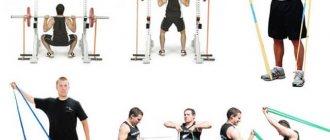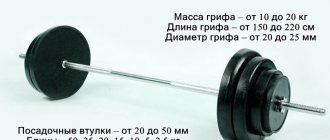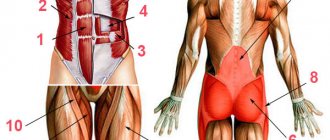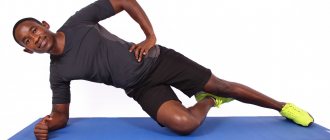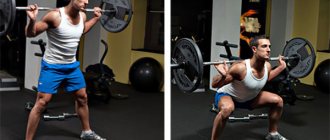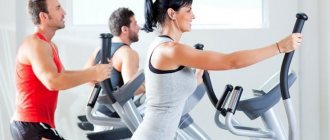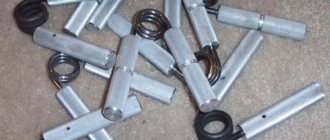Share:
Anyone who wants to build muscle mass is concerned with the question, how do muscles grow? Why do some look like “bulls”, others like “skinny deer”, although the only one working hard in the gym? To influence the process of muscle growth, you need to know physiology and properly organize training and rest.
Muscle Growth Factors
Effective formation of new tissues to replace damaged ones is a complex process that depends on several “parameters.” Let's list them:
We recommend reading: What foods contain creatine: where is the drug, is it possible to saturate the body with it with proper nutrition, table of substance content
- Genetic features of muscle structure (thickness of thread-like structures, ratio of fast and slow fibers, number of capillaries and nerve endings).
- Athlete body type. It is believed that a person with any body type can achieve success in bodybuilding, but mesomorphs are most adapted to mass-gaining training.
- Complete rest. In order for a muscle damaged during strength training to recover, you need to give it at least a day of rest and quality eight-hour sleep.
- Calorie diet. To form new fibers, the body requires proteins, fats, carbohydrates and vitamins. All this should be contained in abundance in a bodybuilder’s diet.
- Proper strength training. Muscles quickly adapt to loads. Therefore, each lesson should be a little harder than the previous one. In addition, you should change the program frequently.
Age also affects the body's ability to build muscle size. This is due to the amount of hormones produced. After 30 years, testosterone secretion gradually decreases every year. Therefore, athletes under 30 progress much faster than their older colleagues.
How do muscles grow?
Skeletal muscle consists of bundles of muscle fibers - the structural elements of muscle. Muscle fibers, in turn, consist of hundreds to thousands of myofibrils, depending on the specific muscle. Each myofibril consists of contractile proteins - 1500 myosin threads and 3000 actin. The area between the end of the myosin filaments on one side and the end of the actin filaments on the other is called a sarcomere - the smallest
It turns out that muscles are not lumps or lumps. And the threads, which, when contracting, come closer to each other, and diverge accordingly when relaxing.
Muscle tissue consists of water and proteins. There is also glycogen, lipids, nitrogen-containing substances, salts of organic and inorganic acids, and so on. But to a greater extent, muscle is protein .
And now closer to the point: what causes muscles to grow? Protein is a building material for thickening muscle fibers. If you eat enough protein, your hormones will cause the protein to thicken your muscle fibers during exercise. That is, muscles grow not from microtraumas, but from thickening of muscle fibers.
With a microtear, the muscle swells, becomes inflamed, and becomes filled with water. Accordingly, it increases. But this cannot be called growth. As a result, the rupture site is overgrown with fibrous connective tissue that is unable to contract. This is trauma. Growth occurs due to the presence of anabolic hormones, amino acids - building elements, hydrogen ions, free nucleotides, as well as vitamins involved in most biochemical processes.
We recommend reading: Muscle pain after exercise - good or bad
How to build the right training algorithm
As befits a conclusion, the most important information will be described below on how to determine for yourself an algorithm (even a conditional one) that will be worked out in such a way as to effectively influence muscle growth.
So, let's go, the algorithm is as follows:
- For beginners and all those who have recently started going to the gym, this type of training called pumping is best suited. That is, put heavy weights aside and work with light weights, the main thing here is to take into account the large number of repetitions of the exercise (15-20). This type of training will significantly speed up muscle capillarization (the formation of new capillaries that nourish the muscles), branch out the branches of blood vessels to the maximum, and also determine for yourself the individually correct technique for performing certain exercises. Conclusion: work with light weights, pump your muscles with blood, determine the correct exercise technique.
- Do not lose sight of the innervation of muscle fibers (that is, the connection between the brain and muscles). You need to feel the tension throughout your body as you perform the exercise. You should notice how impulses literally “run” through the body from the head to the muscles being trained. How to do it? Read the tips above.
- One of the main secrets to the success of the whole muscle growth endeavor is hyperplasia. Alternate basic exercises, for example, with pumping, and the result will be obvious.
- As soon as the work on increasing the number of muscle fibers is completed, it’s time to start working on their “quality”, that is, think about hypertrophy. “Explosive” presses, plyometrics, “explosive” push-ups will come to the rescue.
- After this, you can calm down a little and move on to the athlete’s usual type of strength training. Work with a range of 6-8 repetitions. It’s better to start small and bring it to the maximum, then set a new bar, and again in a circle for 6-8 repetitions. Don’t forget to monitor the frequency of your workouts: at each subsequent workout you need to perform the volume from the previous one (and this is the minimum), and if it doesn’t work out, then one workout per week needs to be thrown out of the schedule.
- And then repeat everything in a circle: hyperplasia -> hypertrophy -> hyperplasia -> hypertrophy and so on. Don’t be lazy to alternate and combine; in general, work persistently to get to your goal.
That's all for sure now.
How fast do muscles grow?
With regular exercise, muscle growth is noticeable almost immediately. Over time, the growth rate decreases. A month of working with a barbell or dumbbells gives a good visible effect. The increase in chest volume can reach 5 cm, muscle mass increases by 2-2.5 kg.
After three months of serious training, muscle mass can increase by 5 kg, the girth of the biceps increases by 3 cm, and the chest by 6 cm. Over the course of a year of training, the biceps “grows” by another 5 cm, and the muscle mass becomes heavier by 10 kg.
The results of training largely depend on your body type and individual characteristics. Genetic factors are no less important. It is also important to provide the muscles with proper rest. Research shows that after exercise, your arms, shoulders and abs need 48 hours to recover. Legs, chest and back require 72 hours. During this time, muscle protein synthesis will be completely completed. How to train to grow muscles? Experts advise sticking to the “schedule”:
- Option 1: lower body - Monday or Friday, upper body - Wednesday;
- Option 2: shoulders, arms, abs - Monday, back and chest - Wednesday, legs - Friday;
- Option 3: top + bottom - Monday and Friday.
To pump up muscles, you need to “drive” the body into a stressful state. This is achieved by changing the load and intensity of the exercises. At the end of the training, it is important to provide the body with the good rest necessary for muscle recovery and growth.
Triggers of Muscle Growth
Natural muscle growth is based on its ability to constantly overcome increasing tension/load. This stress is a major factor involved in muscle development and it disrupts homeostasis in the body. Stress and subsequent disruption of homeostasis trigger three primary mechanisms that stimulate muscle growth.
No. 1. Muscle tension
To increase muscle growth, you must apply a load greater than what your body has adapted to. How to do it? The main way is to lift heavier weights. This additional stress causes changes in muscle chemistry that allow for growth factors that include activation of mTOR and satellite cells. Muscle tension has the greatest effect on the connection of motor units to muscle cells.
No. 2. Muscle damage
Muscle pain after training is damage from the load, another trigger for muscle growth. Local muscle damage causes the release of inflammatory molecules and immune system cells, which activate satellite cells so they can go into action. It is not at all necessary that you should experience muscle pain (pain) after training. It is more important that the damage from training is present in your muscle cells (is inside).
Muscle soreness dulls over time and is weakened by other mechanisms, so often athletes with experience (more than one year) do not experience virtually any pain after lifting weights.
No. 3. Metabolic stress
Stress at work will in no way affect the growth of your muscles, but the “burn” of the muscle from exercise (burning/pumping effect) is precisely the effect of metabolic stress. Metabolic stress causes the cells around the muscle to swell, which helps contribute to muscle growth without necessarily increasing the size of the muscle cells themselves. From the addition of muscle glycogen, the muscles begin to swell along with the proliferation of connective tissue. This type of growth is known as sarcoplasmic hypertrophy. It is one of the ways in which you can achieve increased muscle size without increasing strength.
We recommend reading: How to pump up your body at home
These three mechanisms are the basis of muscle growth, but they are not the only ones that contribute to hypertrophy.
Training FAQ
In this section we will answer frequently asked questions by novice athletes.
Question: What type of training promotes muscle growth?
Answer: In order for muscle fibers to increase in volume, strength training is necessary. The basis of training should be deadlifts, squats with a barbell, bench press, performed for 3-4 sets of 8-12 repetitions.
In addition to the “base”, you should do 2-3 isolation exercises for the target muscle group (3-4 sets of 12-15 repetitions). It is recommended to complete mass-building training with pumping loads (1-2 elements with a minimum weight for 2-3 sets of 15-20 repetitions).
Question: what should a vacation be like?
Answer: first of all, remember - muscles grow not during, but after training. Therefore, rest plays a vital role in building a powerful athletic body. Recovery time is from 1 to 3 days. During this period, healing of microtraumas received during strength training occurs.
In addition, bodybuilders should sleep well (8–9 hours), since it is at night that the hormone somatotropin is produced, which is responsible for the growth of muscle mass and the reduction of body fat.
Question: What is super compensation?
Answer: supercompensation is a period characterized by a higher level of performance of the athlete compared to the initial one. This phase occurs during moments of rest, when the body has restored damaged tissues and replenished energy losses. It is at this moment that it is recommended to conduct the next strength training session.
Scientists have proven that supercompensation manifests itself on the second or third day after exercise (subject to high-quality recovery). This means that to achieve results in increasing body weight, you need to do 2-3 workouts per week.
Question: do muscles grow from pumping?
Answer: There is no scientific evidence to support the benefits of pumping for increasing muscle size. It is believed that high-repetition work with light weights is ineffective, since it has virtually no impact on stimulating growth.
On the other hand, some professional athletes include pumping exercises in their training. They explain this by the fact that pumping elements make it possible to increase micro-tears resulting from power loads and improve the supply of nutrients to the muscles. As a result, in their opinion, better hypertrophy occurs.
Question: do muscles grow from athletics?
Answer: no, they don’t grow. More precisely, not for everyone. A slight increase in muscle mass can only be observed in sprinters, as they perform the most intense and short races. In such athletes, as a rule, the leg muscles increase, but the upper body remains underdeveloped.
Of course, at world competitions you can see physically strong black runners who look like gym goers. But this “form” is associated with genetic characteristics.
Question: do muscles grow from static exercises?
Answer: an increase in muscle volume occurs due to the healing of micro-tears in the fibers. Such damage appears only when performing amplitude exercises with heavy weight.
Static loads cannot create the necessary tensile effect. The main functions of such elements are the development of strength and endurance of muscles and ligaments. Therefore, “statics” cannot be used as the basis for mass-gaining training.
Question: is it possible to build “lean” muscles and burn subcutaneous fat at the same time?
Answer: theoretically, yes. But to achieve this state, it is necessary to combine strength and aerobic training. The combined regimen is suitable only for trained athletes who have been training for at least 1 year and already have a shortened recovery period. Beginners are not recommended to combine different types of training, as this can lead to the development of symptoms of overtraining and stop progress.
Beginning bodybuilders who are overweight, first of all, need to lose weight. The more subcutaneous fat an athlete has, the lower his testosterone level and the worse he will perform at strength training. We recommend starting with simple running or even walking. After the amount of subcutaneous fat drops to at least 23-25% of the total body weight, you can begin strength training.
Question: how do you know that muscles are growing?
Answer: the most accurate indicators are a change in the reflection in the mirror and an increase in the numbers on the scales. To more accurately determine the results, take control measurements 2 times a month using a soft measuring tape. Keep a diary in which you will write down the parameters. This will allow you to track the dynamics of progress and will once again motivate you.
It is believed that muscle pain is an indicator of muscle growth. In fact, pain only means that the fibers received microtrauma during training. The increase in volume will depend on how the athlete rests and eats. It is important to distinguish muscle pain from injury, and if the latter occurs, take measures for recovery.
Question: How fast do muscles grow?
Answer: for each athlete the result is individual and depends on several factors (discussed in the previous section). As a rule, beginners who train “naturally” can gain up to 18–20 kg in the first year. In this case, 8–10 kg will be muscles, and the rest will be water and fat. This is considered a very good result.
With each subsequent year, the number of kilograms gained will decrease. This is due to the gradual adaptation of muscle fibers to strength training. Therefore, it is necessary to frequently change programs and regularly increase weight loads.
Question: Why do some muscles grow quickly and others slowly?
Answer: depends on the ratio of different types of fibers. The more fast glycolytic (white) thread-like structures in a muscle bundle, the stronger the muscle and the faster it increases in size. The degree of loading of the fibers also affects growth. For example, the calf and soleus muscles support an athlete's body weight every day. Therefore, they have a high endurance threshold and because of this they grow extremely slowly.
The basis of sports nutrition is protein
Muscle is protein. To gain muscle mass, an athletic person needs to consume approximately 2 grams of protein per kilogram of body weight per day. This is 100–160 grams of protein per day. Where can I get it?
Animal protein
Sources of animal protein (per 100 grams):
- tuna, 30 grams
- cottage cheese, 25 grams
- cheese, 25 grams
- beef, 25 grams
- duck, 20 grams
- eggs, 15 grams
Products of animal origin are easier to digest, since their structure is similar to human cells and tissues.
Vegetable protein
Vegetable protein sources (per 100 grams):
- spirulina, 70 grams
- legumes, 25 grams
- soy, 25 grams
- seitan, 25 grams
- nuts, 25 grams
- seeds, 20 grams
Vegetable protein is digested worse than animal protein, so you need to eat about 20% more of it. More examples of plant-based protein foods were given in the article about sports nutrition for vegetarians.
Calculate your ideal sports weight!
The Role of Protein Synthesis in Muscle Gain
Each cell in the human body contains only one nucleus, while muscles have a large number, which allows them to synthesize new, high-quality proteins that consist of a certain amount of amino acids. The nuclei of muscle cells signal the ribosomes to synthesize the required type of protein.
If you don't supply your muscles with the necessary building material, they simply won't be able to grow. Once again, as you can see, it all comes down to nutrition.
Muscle tension and its effect on muscles
The tension created by the muscle during exercise is another critical element. It is responsible for launching the protein synthesis mechanism, signaling the muscle cells to feed the “affected” fibers.
Thanks to this, new tissue appears, muscle mass and volume increase. Receptors in cells are very sensitive to maximum loads and high voltage. This is why all professional bodybuilders advise exercising as long as your strength allows.
It is necessary to cross the pain threshold to start the process of protein synthesis and supercompensation.
The role of hormones in the training process
Muscle growth is built on 3 “pillars”:
- Testosterone
- Insulin
- A growth hormone
Each of these hormones has a powerful effect on muscle cells. Insulin speeds up the process of delivering protein to the muscles. The potassium-sodium pump carries out the process of transferring amino acids to muscle tissue. The other two hormones, on the contrary, act on muscle fibers and cause them to disintegrate. This whole process is only possible under powerful loads.
The role of amino acids
An amino acid is a protein particle. The necessary protein is built from them. 1 type of protein contains several types of amino acids. Your weight gain results depend entirely on how much protein you consume in your diet.
The required amount of protein is determined by the intensity level of the training process. Also, in addition to protein, calories play an important role, which supply the necessary energy for complex physical exercises.
Fiber types and skeletal muscle hypertrophy[edit | edit code]
The power developed by a muscle depends on its size and the composition of muscle fibers. Skeletal muscle fibers are divided into two main categories: slow twitch (type 1)
and fast twitch fibers
(type II)
. The differences between these two fibers include metabolism, contraction rate, neuromuscular differences, glycogen stores, capillary density, and response to hypertrophy [13].
Type I fibers[edit | edit code]
Type I fibers, also known as slow twitch muscle fibers, are responsible for maintaining body posture and skeletal bones. The soleus muscle is an example of predominantly slow-twitch muscle fibers. An increase in the density of the capillary network is characteristic of type I fibers because they are more actively involved in activities that require endurance. These fibers are capable of contracting for a long time. Fibers of this type require a lower level of excitation to cause contraction, but they also develop less power. They use fats and carbohydrates better due to increased oxidative metabolism (the body's complex energy supply system that converts energy from the breakdown of substances with the assistance of oxygen).
Type I fibers have been shown to significantly hypertrophy due to progressive overload [14][15]. It is interesting to note that this increase in type I fibers is caused not only by strength training, but also to some extent by aerobic exercise[16].
Fiber type II[edit | edit code]
Type II fibers can be found in muscles that produce more force for shorter periods of time, such as the gastrocnemius and vastus lateralis. Type II fibers can be further classified into type IIa and type IIb muscle fibers.
Fiber type IIa
Type IIa, also known as fast glycolytic muscle fibers, is a hybrid variant between type I and IIb fibers. Type IIa have the characteristics of Types I and IIb fibers. They rely on anaerobic reactions (producing energy without oxygen) and oxidative metabolism to maintain contraction.
Through resistance exercise as well as endurance training, type IIb fibers are converted to type IIa fibers, resulting in an increased proportion of type IIa fibers in the muscle. Type IIa fibers also increase cross-sectional area, which leads to hypertrophy during strength training. With disuse and atrophy, type IIa fibers revert back to type IIb.
Type IIb fibers
Type IIb are fast glycolytic fibers. These fibers rely only on anaerobic metabolism to provide energy for contraction, so they have a high amount of glycolytic enzymes. These fibers generate the greatest amount of force due to the increased size of neuronal cell bodies, axons, and muscle fibers, higher alpha motor nerve conduction velocities, and a higher amount of excitation required to trigger an action potential. Although this fiber type is capable of generating the greatest amount of force, it also contracts for the shortest time (of all muscle fiber types).
Type IIb fibers convert to type IIa during resistance exercise. Strength training is thought to cause an increase in oxidative capacity in trained muscles. Since IIa fibers have a greater oxidative potential than type IIb, this change is a positive adaptation to training conditions.
